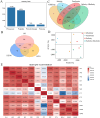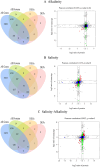Transcriptomic and proteomic analyses provide insights into the adaptive responses to the combined impact of salinity and alkalinity in Gymnocypris przewalskii
- PMID: 38647776
- PMCID: PMC10992934
- DOI: 10.1186/s40643-022-00589-1
Transcriptomic and proteomic analyses provide insights into the adaptive responses to the combined impact of salinity and alkalinity in Gymnocypris przewalskii
Abstract
Gymnocypris przewalskii is the only high-land endemic teleost living in Qinghai Lake, the largest saline-alkaline lake in China. Its osmoregulatory physiology remains elusive due to a lack of precise identification of the response proteins. In the present study, DIA/SWATH was used to identify differentially expressed proteins (DEPs) under alkaline (pH = 10.1, carbonate buffer), saline (12‰, sodium chloride), and saline-alkaline [carbonate buffer (pH = 10.1) plus 11‰ sodium chloride] stresses. A total of 66,056 unique peptides representing 7,150 proteins and 230 DEPs [the false discovery rate (FDR) ≤ 0.05, fold change (FC) ≥ 1.5] were identified under different stresses. Comparative analyses of the proteome and transcriptome indicated that over 86% of DEPs did not show consistent trends with mRNA. In addition to consistent enrichment results under different stresses, the specific DEPs involved in saline-alkaline adaptation were primarily enriched in functions of homeostasis, hormone synthesis and reactions of defense response, complement activation and reproductive development. Meanwhile, a protein-protein interaction (PPI) network analysis of these specific DEPs indicated that the hub genes were ITGAX, MMP9, C3, F2, CD74, BTK, ANXA1, NCKAP1L, and CASP8. This study accurately isolated the genes that respond to stress, and the results could be helpful for understanding the physiological regulation mechanisms regarding salinity, alkalinity, and salinity-alkalinity interactions.
Keywords: Gymnocypris przewalskii; Alkalinity; DIA/SWATH; Salinity.
© 2022. The Author(s).
Conflict of interest statement
The authors declare no competing interests.
Figures






Similar articles
-
Transcriptomic and proteomic strategies to reveal the mechanism of Gymnocypris przewalskii scale development.BMC Genomics. 2024 Feb 3;25(1):140. doi: 10.1186/s12864-024-10047-1. BMC Genomics. 2024. PMID: 38310220 Free PMC article.
-
Transcriptomics and proteomics provide insights into the adaptative strategies of Tibetan naked carps (Gymnocypris przewalskii) to saline-alkaline variations.BMC Genomics. 2025 Feb 19;26(1):162. doi: 10.1186/s12864-025-11336-z. BMC Genomics. 2025. PMID: 39972273 Free PMC article.
-
A TMT-Based Proteomic Analysis of Osmoregulation in the Gills of Oreochromis mossambicus Exposed to Three Osmotic Stresses.Int J Mol Sci. 2025 Mar 20;26(6):2791. doi: 10.3390/ijms26062791. Int J Mol Sci. 2025. PMID: 40141432 Free PMC article.
-
Genomic signature of accelerated evolution in a saline-alkaline lake-dwelling Schizothoracine fish.Int J Biol Macromol. 2020 Apr 15;149:341-347. doi: 10.1016/j.ijbiomac.2020.01.207. Epub 2020 Jan 27. Int J Biol Macromol. 2020. PMID: 32001281
-
Gymnocypris przewalskii decreases cytosolic carbonic anhydrase expression to compensate for respiratory alkalosis and osmoregulation in the saline-alkaline lake Qinghai.J Comp Physiol B. 2016 Jan;186(1):83-95. doi: 10.1007/s00360-015-0939-z. J Comp Physiol B. 2016. PMID: 26475604
Cited by
-
Integrative Analysis of Hepatopancreas Transcriptome and Proteome in Female Eriocheir sinensis under Thermal Stress.Int J Mol Sci. 2024 Jun 30;25(13):7249. doi: 10.3390/ijms25137249. Int J Mol Sci. 2024. PMID: 39000358 Free PMC article.
-
Transcriptomic and proteomic strategies to reveal the mechanism of Gymnocypris przewalskii scale development.BMC Genomics. 2024 Feb 3;25(1):140. doi: 10.1186/s12864-024-10047-1. BMC Genomics. 2024. PMID: 38310220 Free PMC article.
-
Proline metabolism is essential for alkaline adaptation of Nile tilapia (Oreochromis niloticus).J Anim Sci Biotechnol. 2024 Oct 14;15(1):142. doi: 10.1186/s40104-024-01100-w. J Anim Sci Biotechnol. 2024. PMID: 39397002 Free PMC article.
-
Integrated miRNA-mRNA analysis uncovers immediate-early response to salinity stress in gill-derived cell line of Gymnocypris przewalskii.BMC Genomics. 2024 Oct 15;25(1):965. doi: 10.1186/s12864-024-10869-z. BMC Genomics. 2024. PMID: 39407113 Free PMC article.
-
Genetic Basis and Identification of Candidate Genes for Alkalinity Tolerance Trait in Spotted Sea Bass (Lateolabrax maculatus) by Genome-Wide Association Study (GWAS).Mar Biotechnol (NY). 2025 Jan 9;27(1):27. doi: 10.1007/s10126-024-10405-w. Mar Biotechnol (NY). 2025. PMID: 39786505
References
-
- Benjamini Y, Hochberg Y. Controlling the false discovery rate: a practical and powerful approach to multiple testing. J Royal Statistical Society Series b: Methodol. 1995;57(1):289–300.
-
- Betts J, et al. Anatomy and Physiology. Houston: Rice University; 2013.
Grants and funding
LinkOut - more resources
Full Text Sources
Research Materials
Miscellaneous

